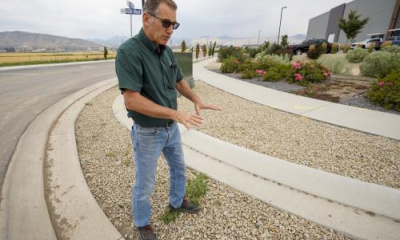Utah lawmakers are notoriously resistant to ceding any land to federal control, but supporters say a national park could shine a worldwide spotlight on the Great Salt Lake’s importance.
The idea of a Great Salt Lake national park has made a splash in recent weeks, but the likelihood of it happening doesn’t hold much water.
National parks are created by an act of Congress using land the federal government already owns, usually managed by the U.S. Bureau of Land Management or the U.S. Forest Service. The state of Utah owns basically most of the Great Salt Lake, including Antelope Island, Fremont Island, Gunnison Island, the Ogden and Farmington bay wetland areas, along with the entire lakebed. Theoretically, the state could sell or donate those lands to the feds, but as ongoing conflicts at Bears Ears and Grand Staircase Escalante national monuments show, Utah officials are pretty resistant to putting out the welcome mat to more federal government control.
“It would be a little unprecedented,” said Ben Stireman, sovereign lands program administrator for the Utah Division of Forestry, Fire and State Lands, the state agency which manages the lakebed. “There’s almost no appetite to trade out the Great Salt Lake or sell the Great Salt Lake.”
This year, a group of Brigham Young University students floated the notion of a national park in earnest. They even traveled to Washington, D.C., to meet with Utah’s congressional delegation last month.
(The offices of Sen. Mitt Romney and Rep. Blake Moore, who were behind recent federal bills benefiting the Great Salt Lake, did not immediately respond to a request for comment.)
“Everyone was very gracious in letting us in,” said Addison Graham, an American studies major who starts his senior year in the fall. “The last thing they want to do is tell a group of BYU students to get lost.”
But the students quickly got the impression Utah’s congressmen weren’t on board.
“What we heard is ‘It’s a state issue, Gov. [Spencer] Cox is doing a great job,’” Graham said. “What we didn’t hear were a lot of feasible solutions.”
The Great Salt Lake has hit record lows two years in a row. Its ecosystem, which supports millions of migrating birds, was nearly wiped out. Its desiccated lakebed has dried to toxic dust which threatens the health of millions of Wasatch Front residents. Although a record-breaking snowpack has raised the lake an astounding 5.5 feet this spring, it needs about five feet more to reach a safe and sustainable level.
And there’s no guarantee Utah will ever see a winter like this again.
The students’ proposal is more realistic than making the entire Great Salt Lake a federally managed resource. Instead, they suggest smaller national park units around the lake, including wetlands areas, a portion of the Promontory Point peninsula and the Bonneville Salt Flats. They reason a national park will bring worldwide attention to the lake, along with its unique wildlife, Indigenous history and dwindling water supply. They urged lawmakers to at least consider a feasibility study.
“We want to show people it has national park potential. It is a treasure,” said Valeria Prieto, an environmental science major who researched the significance of the lake to Native American communities. “It deserves more admiration. Hopefully, that would help with all the conservation efforts going on right now.”
They even conducted a survey which found 67% of Utahns support creating a Great Salt Lake national park.
A historical perspective
Sara Dant, a professor of history at Weber State University and author of Losing Eden: An Environmental History of the American West, said it makes sense a potential Great Salt Lake national park would pique the public’s interest.
“The Great Salt Lake is an extraordinary, unique resource and visual spectacle,” Dant said. “And what do we do with extraordinary, unique, visual spectacles? We make national parks out of them.”
But, she said, it could be divisive, reigniting conservative, Sagebrush Rebellion-era anti-government and anti-environmental sentiments.
“Right now, the lake and it being in crisis is creating consensus,” Dant said. “No matter where you sit on the political spectrum, you can find value in the lake and not want to see it disappear. But when you start talking about bringing in the federal government, that will cause everyone to scurry into their political corners so fast.”
Part of Dant’s book debunks a belief at the heart of the Sagebrush Rebellion movement of the 1980s — that the vast swaths of land managed by the federal government in the West were unfairly seized from the states, who should own and use those lands as they please.
“That’s a false understanding of the relationship between the states and federal government,” Dant said. “The federal government acquired the lands of the West, then made the states, and the states were created with all these federal lands in place.”
Water bodies like the Great Salt Lake and Utah Lake were handled differently, however, because they were navigable and used by residents for commerce at the time Utah became a state. So the federal government handed over the lakebeds to the state with the understanding they would be managed in the public trust for the benefit of all Utahns, instead of getting monopolized by one industry or owner.
The water which fills the lakes is also owned by the people of Utah and managed by the state for the public’s benefit under our complicated system of water rights.
An uneasy tension between state versus federal land control still exists for many Utahns today, however. The Legislature set aside millions in 2016 for a lawsuit asserting their control over BLM and Forest Service lands. This year, some lawmakers implied the federal government’s forest management was to blame for the Great Salt Lake’s plight. And the state remains embroiled in a lawsuit with President Joe Biden’s administration over the Bears Ears and Grand Staircase-Escalante national monuments.
Monuments are different from national parks because they’re established by presidents under the Antiquities Act, but they’re protected in much the same way. Many national monuments were later made parks by Congress, including Arches and Bryce Canyon national parks.
Dant said some of public perception fueling state-versus-feds conflict at least partly stems from a misunderstanding of what public lands are and which agencies manage them.
“A lot of people don’t realize when a president designates a monument, the president isn’t creating new federal land,” Dant said. “So there was a huge outcry when [former President Barak] Obama designated Bears Ears, of ‘Oh my goodness, here’s [1.3] million acres the president has just seized.”
Those lands declared and protected as monuments were existing BLM or Forest Service property. They just got re-characterized for a new purpose, Dant explained.
That means Biden can’t unilaterally make a national monument at the Great Salt Lake, unless it is existing federal land like the Bonneville Salt Flats.
Utah has, however, handed over land it controls to help create a national park unit before. In 1998, the lawmakers agreed to swap 400,000 acres of state-owned land within the Grand Staircase-Escalante National Monument in exchange for 145,000 acres of federal land and $50 million in federal money. They have looked at doing the same for Bears Ears.
But Dant is doubtful the state would agree to a sale or swap of land it manages at Utah’s famous inland sea.
“The state is not going to give up the valuable resource that is the Great Salt Lake,” Dant said. “It’s just not.”
The BYU students supporting a national park, for their part, said they are familiar with the many interests which own, manage and operate on lands in and around the lake.
“It’s not easy to solve,” Prieto said. “It would take a long time to find solutions and see what’s best for all the stakeholders involved.”
Stireman, with the division of state lands, said he doesn’t want those dreaming of a national park to feel disappointed by the slim chance it will ever materialize.
“I would never want to discourage any attention to the Great Salt Lake,” Stireman said. “We need people to be aware of its importance, and why we want to work so hard to protect the lake.”









